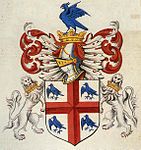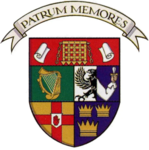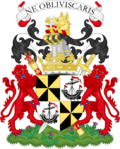Traditions
American Tradition
As the use of coats of arms may be seen as a custom of royalty and nobility, it had been debated whether the use of arms is reconcilable with American republican traditions. Families from English, Scottish, Irish, Welsh, German, and other European nations with a heraldic tradition have retained their familial coat of arms in the United States. Several founding fathers also employed personal arms and a great number of Americans continue to do so.
British Tradition
British heraldry (or more precisely Anglo-Irish heraldry) is a collection of similar traditions, encompassing both the tradition practiced by the College of Arms, as well as the Irish tradition practiced by the Office of the Chief Herald of Ireland. The Anglo-Irish tradition is also the main tradition of Australia, New Zealand as well as most of the Commonwealth and the most important basis for heraldry in Canada, The United States and South Africa.
Features
Anglo-Irish heraldry is known to feature generally more animal-based and detailed crests than most continental traditions. It also Traditionally, women are expected to utilise a lozenge or oval instead of a traditional escutcheon. The English tradition, while having a system of cadency, does not enforce said cadency. Nonetheless cadency is very often practiced and quartering is usually applied when possible. It also allows individuals to bear identical escutcheons, as long as each achievement is unique (i.e. if there are two identical escutcheons, the crests must be different). The Irish tradition, being imported to the island from England, is largely similar but with the addition of sept arms, which allow some relations of the bearer of the senior armiger to display their arms freely. Mantling in the Irish tradition is typically Gules doubled Argent. Armigers in both traditions may utilise a badge and standard, as well as their achievement.
-
The Coat of Arms of Sir Winston Churchill
-
Coat of arms of Arthur Charles Fox-Davies
-
Coat of Arms of Coat of Arms of Kate Middleton. Before becoming the Duchess of Cambridge
Authorities
-
The College of Arms
(England and the British Commonwealth (except Canada, Scotland and South Africa)
Canadian Tradition
Canadian heraldry is the heraldic tradition of Canada.
Features
Canadian heraldry is heavily influenced by British heraldry but takes creative elements from other traditions, most notably indigenous Canadian art. De to the multicultural background of the Canadian population, this tradition is fairly liberal in its rules and adherence to tradition, taking elements of various other traditions and para-heraldic practices. Canadian heraldry notably uses a variety of unique helmets not found in other heraldic traditions, such as Corinthian helmets, nasal helmets, UN Peacekeeping helmets, parka hoods, and even astronaut helmets. It also uses a variety of shield shapes, including round shields inspired by drums for some indigenous armigers. Indigenous art styles are incorporated into Canadian heraldry, and some charges may be blazoned as being depicted in a certain art style. Canadian heraldry is also known for a more wide spread use untraditional tinctures, such are bleu-céleste, rose or even copper. To be noted nonetheless, this trend seem to have diminished in important in recent years. It also features a system of cadency distinct from British cadency which acknowledges female inheritance. Canadian armigers may utilise a badge and standard, as well as their achievement.
-
The Coat of Arms of Julie Payette
Authorities
Germanic Tradition
Germanic Heraldry is the form of coat of arms and other heraldic bearings found in Germany, Austria and Switzerland, but its influence can also be found in the former territories of Austria-Hungary, and the German Empire.
Features
One of the most prominent differences to the surrounding heraldic traditions is the approach to crests. Compared to other traditions, germanic heraldry sees a higher usage of wings, horns, and hats as parts of the crest. Wings and helmet plates are also sometimes used as a “Hilfskleinod”, repetition of the entire (or large parts) of the shield design on top of the crest figure.
Sometimes the use of a torse is seen as optional, especially in the case of animal crests. Here, it is not uncommon to have the fur of the crest transition seamlessly into the mantling.
In regards to tinctures, furs and the colour purpure are rarely used. This last one mostly limited to details on crowns, hats or the insides of a helmet. Germanic Heraldry also tends to approach proper as hinting toward using the closest traditional tincture rather than the actual natural colour.
None of this system have a system of cadency, all descendent of the armiger inherit his arms equally and quartering is a fairly limited practice.
-
Coat of arms of Kärnten
-
Coat of arms of Robert Krätschmar
-
Coat of arms of Styria
Authorities
Due to the political situation in the german lands, the germanic tradition never developed a central authority. Instead, there is a plenitude of heraldic associations, assisting with the creation and assumption of new arms, as well as the documentation of arms via periodically publishing roll of arms.
Iberian Tradition
Portuguese Heraldry and Spanish Heraldry are the two traditions that compose the Iberian Tradition, sharing key aspects and elements throughout history. Arms, other heraldic bearings and insignia used in the Portugal and Spain as in their colonial empires and historical territories.
Features
The main feature of this tradition is the use of the Iberian Shield (squared top and rounded bottom, also called "Peninsular", "Spanish" or "Portuguese") which appearance and use was most prevalent in Iberia.
Crests and helmets worn atop the shield are also common in Spain and Portugal. The use of a belt to attach the shield to the helm is also prominent in both countries.
Portuguese Heraldry is known for it's versatility in inheritance, armigers being able to equally inherit from the paternal and maternal line.
Both tradition have a system of cadency, but whereas the Spanish one is barely used, the Portuguese one strictly applied.
The use of ordinaries like bordures and orles' are a common trait. Words or letters as well as quartering as marshalling of arms are extremely used by both systems.
Authorities
Lowlands Tradition
Dutch heraldry and Belgian heraldry is the form of coats of arms and other heraldic bearings and insignia used in the Kingdom of the Netherlands, the Kingdom of Belgium, the Grand Duchy of Luxembourg and the Dutch and Belgian colonial empire but also in the historical territories that make up the Lowlands (or Nederlands).
Features
The different traditions in the lowlands are the result of mixed influences, especially German and French. It is thanks to the work of people such as J. B. Rietstap in the XIX th century that the lowland really developed a distinct and codified tradition. Due to the history of the lowlands as a trading hub, it's not uncommon to encounter arms originating from other tradition especially Portuguese arms.
The main feature of this tradition is the use of the barred helmet (often with a golden trim and a collar) and that for all individual they be from nobility or not. The use of a belt to attach the shield to the helm is also prominent, especially in Belgian heraldry. Traditionally, the torses of Nederlandse coat of arms also have five twists contrary to the six often seen in the British isles.
Crest in the lowlands usually features typically Germanic charges such as wings or horns but many also feature demi-human figures, especially those that date back to after the Dutch Revolt (1566).
Belgian Heraldry is also known for blazoning not only the motto but the scroll, indicating the colours of the letters and of the scroll itself.
Both system do not have a system of cadency, all descendent of the armiger inherit his arms equally. In the late Middle Ages arms were often distinguished by changing one of its feature (usually tinctures or number of charges) but this is no longer the case for modern grants.
-
Coat of arms of Johannes Theodorus van Spengler and his descendant
-
Coat of arms of Kevin Haelterman and his descendant
Authorities
-
Hoge Raad van Adel
High council of Nobility (Municipalities and Nobility)
-
Vlaamse Heraldische Raad
Flemish Heraldic Council (Flanders and Brussels-Capital Region) -
Conseil d’Héraldique et de Vexillologie
Council of Heraldry and Vexillology (Wallonia and Brussels-Capital Region)
References
Jonannes Baptista Rietstap, Handboek der Wapenkunde, G. B. van Goor Zonen, 1857
Honoré Rottier & Marc Van De Cruys, Heraldiek, Davidsfonds Uitgeverij, 2004
Benoit Kervyn de Volkaersbeke, Wapen-schilden in Brugse straten, Uitgaven West-vlaamse Gidsenkring, 2020
WAZAMAR, Heraldische Wapens in de Nederlanden, 'Wapenrecht', 1995
Jonannes Baptista Rietstap, Armorial général: précédé d'un dictionnaire des Termes du blason, 'Vol.I', G. B. van Goor Zonen, 1884
Jonannes Baptista Rietstap, Armorial général: précédé d'un dictionnaire des Termes du blason, 'Vol.II', G. B. van Goor Zonen, 1884
Contact of the Vlaamse Heraldische Raad
Website of the Nederlands Genootschap Voor Heraldiek
Lecture - The Heraldries of the Netherlands and Belgium
Nordic Heraldry
Nordic heraldry is the heraldic tradition of the Nordic countries ( Denmark, Sweden, Norway, Finland and Iceland). All those traditions are very alike with some minor differences. In addition to the nobility, gradually also commoners and even some farmers used arms. During 20th century interest in heraldry has again increased. Assuming arms was and is not regulated, and anyone can bear arms.
Features
Nordic heraldry is a part of German heraldic tradition and is quite similar to it. Arms are often rather simple and stylized, with few charges and tinctures. Canting arms are common.
Standard heraldic tinctures are used. Purple is very rare and even restricted in its use, but in recent Swedish heraldry used more. Natural colours (proper) are mostly avoided in modern heraldry. Furs are rather rare.
House marks were historically a common charge in burgher arms, nowadays accepted if they follow heraldic rules and can be blazoned in heraldic terms.
Variations of line are common, especially in Finnish heraldry (which has created a few new variations, like fir-twigged and fir-tree-topped).
In Sweden and Finland, the open helmet is used only by the nobility and burgher arms use a tilting helmet, while in Denmark and Norway both nobles and commoners may use an open helmet. The number of helmets above the shield indicates the noble rank.
Sometimes the use of a torse is seen as optional, especially if the crest transitions seamlessly into the mantling. Bull horns, eagle wings and flags are common in crests, and the crest quite often repeats the charge or colours/pattern of the shield.
All those traditions do not have a fixed system of cadency, all descendent of the armiger inherit his arms equally. Though historical coats of arms are still inherited agnatically, it is often no longer true for modern coats of arms. Differencing the arms by changing the shield elements and/or the crest is sometimes done.
-
Canting coat of arms of the family Bjelke (meaning beam)
-
Coat of arms of Ahti Hammar
Authorities
Personal heraldry is not regulated in Nordic counties and there is no heraldic authority for it. Instead, there is a plenitude of heraldic associations, assisting with the creation and assumption of new arms, as well as the documentation of arms via periodically publishing roll of arms.
Polish-Lithuanian-Ruthenian Tradition
Polish-Lithuanian-Ruthenian heraldry in the heraldic tradition originating from Poland later spread to all territories under the control of the Polish-Lithuanian Commonwealth and to the lands in its immediate neighbourhood as well as by their diaspora.
Some of the oldest examples of heraldry, including arms borne by the most prominent historical personalities in Poland, Lithuania, Belarus and Ukraine, existed within the framework of the Polish heraldic tradition. Nobles in the historical principality of Moldavia, covering parts of the present-day Romania and Moldova, also often bore arms originating from this tradition. Heraldry in Muscovy originated from Polish heraldic practices, but eventually evolved into a separate jurisdiction and a distinct Russian tradition.
Features
Arms from this tradition are commonly depicted on either half-round Iberian shields or on more ornate but still rather simple "Polish" baroque shapes. Common charges include various mixed geometric shapes (often inspired by pre-heraldic symbols of the region such as Tamgas), arrows and other weapons, celestial bodies. Common types of crests include ostrich and peacock feathers and wings, either plain or with additional charges. Repetition of charges from the shield in the crest is, too, fairly wide spread. Due to a lack of regulation and precedent, it is not unclear how a proper achievement assumed by a citizen should look like. Indeed, mon-noble heraldry was non-existent in this tradition, resulting in a lack of a ranked helm system. The arms borne by an untitled nobleman would have had a shield and a crest upon a crowned iron helm with golden bars and a golden necklace Polish-Lithuanian-Ruthenian heraldry does not have a system of cadency, all male descendent of the armiger inherit his arms equally. Every unique Polish noble achievement has a name, with their "alterations" having the same name with a number added.
-
Dołęga coat of arms of borne namely by Marie Curie (Maria Salomea Skłodowska)
-
Kościesza coat of arms
-
Piłsudski coat of arms borne namely by Józef Piłsudski and derived from the arms of Kościesza
-
Rawicz Coat of arms
Authorities
Lithuania
Lithuania has no governmental body regulating heraldry
Belarus
Belarus has no governmental body regulating heraldry
Ukraine
Ukraine has no governmental body regulating heraldry
Scottish Tradition
Scottish heraldry is the form of heraldic visual identity utilised in Scotland, as well as by its diaspora. It is distinct from the tradition of the rest of the United Kingdom.
Features
A distinctive feature of this tradition is the bearing of mottos above the crest in achievements (with slogans or war cries placed beneath the escutcheon).
The Scottish tradition is characterised by a strict enforcement of cadency and differencing, as well as the uniqueness of each entity's armorial bearing.
The idea of a societal clan structure survives in the legal fiction that every individual bearing the same surname is related, and therefore new grants to petitioners may difference the senior arms of their name.
Heraldic compartments originate in Scotland, and are frequently used where supporters are borne.
While conventional heraldic badges are granted for individuals of certain statuses, all armigers are entitled to bear a Scottish crest badge, in which their crest is depicted surrounded by a circlet bearing their motto, with a varying quantity of eagle feathers behind. All those nominally 'following' the armiger may use a crest badge with no feathers, and the circlet replaced with a strap and buckle. Some armiger are also granted more 'classical' heraldic badges similar to those seen , for instance, in England
It is one of the few traditions actively regulated in the present-day.
-
Coat of arms of Alexander Charles Richards Maitland
-
Coat of arms of the duke of Argyll
-
Crest Badge of the Clan Mac Donald









